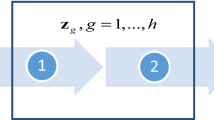Abstract
Nowadays, algorithms and computer programs, which are going to speed up, short time to run and less memory to occupy have special importance. Toward these ends, researchers have always regarded suitable strategies and algorithms with the least computations. Since linear programming (LP) has been introduced, interest in it spreads rapidly among scientists. To solve an LP, the simplex method has been developed and since then many researchers have contributed to the extension and progression of LP and obviously simplex method. A vast literature has been grown out of this original method in mathematical theory, new algorithms, and applied nature. Solving an LP via simplex method needs an initial basic feasible solution (IBFS), but in many situations such a solution is not readily available so artificial variables will be resorted. These artificial variables must be dropped to zero, if possible. There are two main methods that can be used to eliminate the artificial variables: two-phase method and Big-M method. Data envelopment analysis (DEA) applies individual LP for evaluating performance of decision making units, consequently, to solve these LPs an IBFS must be on hand. The main contribution of this paper is to introduce a closed form of IBFS for conventional DEA models, which helps us not to deal with artificial variables directly. We apply the proposed form to a real-data set to illustrate the applicability of the new approach. The results of this study indicate that using the closed form of IBFS can reduce at least 50 % of the whole computations.
Similar content being viewed by others
References
Ali, A., & Seiford, L. M. (1993). Computational accuracy and infinitesimal in data envelopment analysis. INFOR, 31, 290–297.
Amin, G. R., & Toloo, M. (2004). A polynomial-time algorithm for finding \(\varepsilon \) in DEA models. Computer & Operation Research, 31, 803–805.
Banker, R. D., Charnes, A., & Cooper, W. W. (1984). Models for estimation of technical and scale inefficiencies in data envelopment analysis. Management Science, 30, 1078–1092.
Bazaraa, M. S., Jarvis, J. J., & Sherali, H. D. (2010). Linear programming and network flows (4th ed.). New York: Wiley.
Charnes, A., & Cooper, W. W. (1992). Programming with linear fractional. Naval Research Logistics Quarterly, 15, 333–334.
Charnes, A., Cooper, W. W., & Rhodes, E. (1978). Measuring the efficiency of decision making units. European Journal of Operational Research, 2, 429–444.
Cooper, W. W., Seiford, L. M., & Tone, K. (2007). Introduction to data envelopment analysis and its uses with DEA-solver software and references (2nd ed.). New York: Springer.
Mehrabian, S., Jahanshahloo, G. R., Alirezaee, M. R., & Amin, G. R. (2000). An assurance interval for the non-Archimedean epsilon in DEA models. Operations Research, 48, 3444–3447.
Acknowledgments
The research was supported by the Czech Science Foundation (GACR project 14-31593S) and through European Social Fund within the project CZ.1.07/2.3.00/20.0296.
Author information
Authors and Affiliations
Corresponding author
Appendix
Appendix
The standard envelopment form of the CCR model is as follows,
where \(\mathbf{s}^{-}\) and \(\mathbf{s}^{+}\) are the input excesses and output shortfalls respectively, and \(\varepsilon \) is a non-Archimedean infinitesimal. We can obtain an IBFS for model (6) in a similar manner; consider the corresponding coefficient matrix and right hand side vector,
To have an IBFS for this model we must solve the phase I of two-phase method as follows:
According to the feature of the standard envelopment form, columns corresponding to \(\theta \) and \(\lambda _o \) appear in the optimal base, considering this characteristic and doing some computations the optimal base matrix of model (7) can be written as follows,
The closed form of B \(^{-1}\) can be calculated as,
Hence, the following optimal solution will be achieved:
and all other variables are non-basic. Indeed, this solution is a degenerate BFS of order \(m+s-2\) and consequently we expect that the significant number of iterations in phase I will be saved by applying the proposed IBFS.
Now, we have a closed form of an IBFS for the envelopment form of the CCR model to start phase II without solving phase I.
Rights and permissions
About this article
Cite this article
Toloo, M., Masoumzadeh, A. & Barat, M. Finding an Initial Basic Feasible Solution for DEA Models with an Application on Bank Industry. Comput Econ 45, 323–336 (2015). https://doi.org/10.1007/s10614-014-9423-1
Accepted:
Published:
Issue Date:
DOI: https://doi.org/10.1007/s10614-014-9423-1



